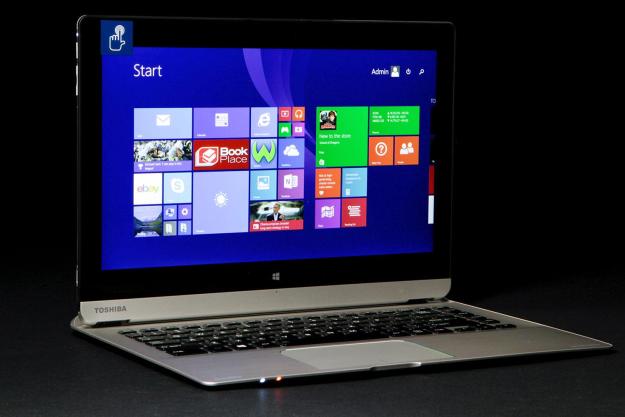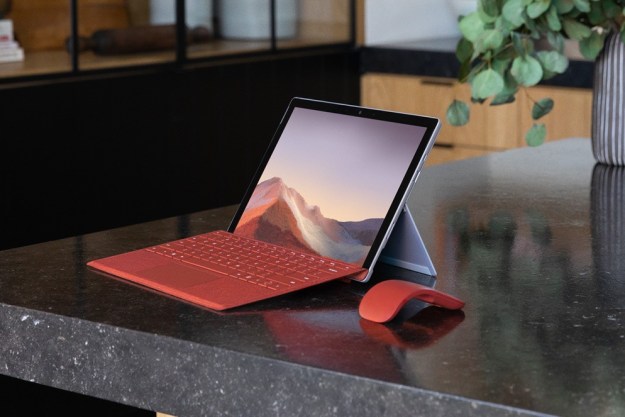
“Toshiba’s Click 2 Pro is powerful, but short battery life, rear port placement, and a wobbly hinge keep it from surpassing the competition.”
- Screen attaches/detaches easily
- Fast SSD and CPU
- Roomy back-lit keyboard
- Short battery life
- Wobbly hinge
- Top-heavy design
- Rear-mounted ports
- Heavy as both a tablet and a laptop
PC makers have been struggling for a couple of years now to craft the perfect convertible laptop that functions well as both a tablet, and a laptop. It’s a tough design problem for several reasons, not the least being that complicated hinges tend to add a fair bit of weight and bulk to devices that strive to be thin and light.
Two of the more popular (or, popularized, at least) convertibles opt for novel ways around this problem. Lenovo’s Yoga and Yoga 2 allow the screen to fold all the way around, rather than detach. This makes for a very heavy tablet, but a laptop that’s still quite thin and light. Microsoft’s Surface tablets instead opt for a sub-par, super-thin snap-on keyboard, rather than a rigid laptop-like hinge. This makes them reasonably light in tablet mode, but far from the best option if you do a lot of typing.
Toshiba instead opted for a detachable screen with last year’s Click, along with a rigid, though heavy, metal hinge. In the interests of keeping costs low, they also opted for a low-power AMD processor, and a slow-spinning mechanical hard drive. The results were far from impressive. To add insult to injury, the second battery failed to function in two different review units that the company sent our way.

To their credit though, Toshiba didn’t give up. Instead, they’ve doubled down on the detachable screen design (literally) by offering two 13-inch variations of their second-generation Click, the mainstream Satellite Click 2, and the higher-end Satellite Click 2 Pro (model P35W-B3226) that we’re looking at here.
Sporting a Core i7 processor, 1080p screen, 128GB SSD, and a much-improved hinge mechanism, it would be a gross understatement to say that the Click 2 Pro is an improvement over the original Click. But it’s also worth noting that with a $1,185 MSRP, the Click 2 Pro is nearly twice the price of the original Click.
The Click 2 Pro is also quite heavy, both as a laptop, at 4.5 pounds, and as a tablet. The screen portion of the Click 2 Pro is about a half-pound heavier (2.3 pounds) than the Surface Pro 3 is without its keyboard.
A mostly metal shell, with a plastic bottom
The Click 2 Pro’s aesthetics are attractive enough, and mostly feel like they belong to a premium device. The lid and keyboard tray are made of brushed metal, while the bottom consists of textured gray plastic.
Tilt the screen too far back, and the base will start to lift up off the desk.
Port selection is okay, and consists of a pair of USB 3.0 ports, HDMI, and an SD card slot. Since the edges of the base are tapered, Toshiba chose to put all the ports (including power and the headphone jack) around back. This will bother some people more than others, but it’s far from ideal if you frequently work in tight spaces, like an airline seat.
When popping off the tablet portion of the Click 2 Pro, the bottom section houses power and headphone jacks, as well as a full-sized USB port, and a Micro HDMI jack. The left side of the tablet houses a MicroSD card slot, which you can use to save hard drive space.
We don’t have any major complaints about the touch-pad. It’s roomy enough for multi-touch gestures. While there are no physical buttons, the click mechanism beneath the pad doesn’t feel too stiff or loose, and generally feels well built.
There’s a 5 megapixel camera on the back that isn’t awful by tablet camera standards, and a 720p web-cam up front for video chat. The Harman/Kardon-branded speakers are pretty good for a tablet, but they don’t put out a lot of volume, or much of anything that could be described as bass.
The hinge is a mixed bag
The hinge on the Click 2 Pro differs both from the original Click, as well as from the lower-end Click 2. Instead of requiring you to press a button to release the mechanism, you just press the screen down onto two posts on the keyboard base, and the two halves literally “click” together, solidly. Press down on the screen again, then lift up, and the screen detaches.
The Click 2 Pro’s battery life isn’t anything to get excited about.
Because the base doesn’t house the PC’s components, you’ll want to hold the base down with one hand to keep it from lifting up or moving around on your desk while you remove the screen. That leads us to the other problem with the system’s overall design.
Much like the similar HP Spectre 13T X2, the Click 2 Pro is top-heavy. Tilt the screen too far back, and the base will start to lift up off the desk—especially when you tap on the touchscreen. If you’re typing on your lap, or you happen to be using a desk that leans a little forward, the laptop can topple over if you aren’t careful. Toshiba has promised a model with a hard drive and second battery in the base, which could help this issue, but will of course cost more. We’re not sure how much more, though, as Toshiba isn’t selling that model yet.

The other issue with the hinge is the copious amount of screen wobble. Expect the Click 2 Pro’s display to wiggle back and forth quite a bit every time you tap the touchscreen. Again, this will bother some people more than others, but we found it to be annoying during our tests.
A nice 1080p touchscreen
The 13.3-inch IPS panelthat comes standard on the Click 2 Pro is pretty good, but not quite great. 1080p resolution feels about right for a screen of this size, especially if you often use traditional Windows apps that haven’t been optimized for touch. The Surface Pro 3 has a higher 2,160 x 1,440 screen, but unless you’re a pixel geek, or you have a tendency to hold the screen a few inches from your face, 1080p is fine.
It would be a gross understatement to say that the Click 2 Pro is an improvement over the original Click.
The Click 2 Pro’s screen is fairly bright, outputting 284 lux at maximum settings in our tests. That’s slightly brighter than the 268 we saw with HP’s Spectre 13T x2. Some laptops and tablets have brighter screens (Dell’s XPS 15, for instance, hit 400 lux). But the Click 2 Pro’s panel delivers above-average brightness. Unless you frequently work in direct sunlight, it should be more than sufficient.
While the screen on HP’s Spectre 13T X2 doesn’t get quite as bright as the Click 2 Pro, it produces a broader 99 percent of sRGB, and 75 percent of the Adobe RGB spectrums. It boasts a 670:1 contrast ratio, which is not quite as good as the Click 2 Pro’s ratio.
Solid Ultrabook-class performance
One of the main downsides of HP’s similarly-designed Spectre 13T X2 is its low-voltage processor. It lets that system function without a fan, but limits performance. Our review unit packs a high-end Ultrabook-class Core i7-4510U processor, along with a 128GB solid-state drive, and an ample 8GB of RAM.
That means you can expect performance that’s requisite with a mid-to-high-end Ultrabook. But when you’re creating or crunching content, or doing other resource-taxing tasks, you’ll have to live with some fan noise. The ruckus isn’t overpowering, and the pitch of the fans isn’t high enough to be annoying (at least to our ears), but they’re definitely audible.
In our SiSoft Sandra Processor Arithmetic benchmark, the Click 2 Pro turned in a score of 30GOPS. That’s not far ahead of the HP Spectre 13T X2’s grade of 28.68. Things tilt further in the Click 2 Pro’s favor in the 7-Zip benchmark. Toshiba’s system turned in a score of 6,743MIPS, besting the HP’s grade of 5,340 in the same test.
In PCMark 8’s storage benchmark, the Click 2 Pro’s SSD delivered a solid score of 4,893, while the Spectre 13T X2 did slightly better, getting a score of 4,902. You can expect speedy boots and program response times from the Click 2 Pro, which is much more than we can say about the original Click, with its slow 500GB hard drive.
The Click 2 Pro shouldn’t be considered a gaming machine, but its Intel HD 4400 graphics GPU is certainly capable of light gaming—especially if you keep game resolutions below the screen’s native 1080p resolution.
In the 3DMark graphics test, the Click 2 Pro delivered a Cloud Gate score of 4,333, and a Fire Strike score of 572. That’s a lot better than what the low-voltage guts of the HP Spectre 13T X2 could muster. That device scored just 1,584 on Cloud Gate, and 190 in the Fire Strike test.
We also ran League of Legends to get a sense of the Click 2 Pro’s real-world gaming chops. At Medium detail and 1080p resolution, the Click 2 Pro delivered an average of 40 frames per second, with a minimum of 20, and a maximum of 54. These numbers aren’t spectacular, but they’re still generally enjoyable, and are much higher than what the Spectre mustered.
HP’s unit got average, minimum, and maximum frame rates of 32, 24, and 39 frames per second in League of Legends at Medium detail.
Battery life isn’t great
The Click 2 Pro’s battery life isn’t anything to get excited about. In fact, it’s short for a modern laptop. In the Peacekeeper Web-based battery life test, it lasted just 3 hours and 17 minutes. That’s far behind the similarly sized Lenovo Yoga 2 13, which got 5 hours and 29 minutes on the same test. And HP’s Spectre 13T, with its dual batteries (one in the base, and one behind the screen), lasted 6 hours and 4 minutes. Even running as a tablet alone, the Spectre outpaced the Click 2 Pro, lasting 4 hours and 6 minutes.
If long battery life is important to you, you’ll have to either wait until Toshiba makes a dual-battery version of the Click 2 Pro available, or look elsewhere.
Conclusion
From the performance, to the screen, to the back-lit keyboard, and simply the fact that it works as advertised, the Toshiba Satellite Click 2 Pro is a huge improvement over last year’s Satellite Click. If you’re set on getting a detachable laptop with a 13-inch screen and more computing power than HP’s Spectre 13T X2, it’s a decent choice.
But aside from its novel hinge mechanism, the Toshiba Click 2 Pro doesn’t really stand out from the multitude of other convertibles. It’s also heavier than most other similarly-sized competitors, while delivering short battery life, and a screen that wobbles annoyingly when swiped or tapped. And if you use your laptop’s ports frequently, their placement at the back of the Click 2 Pro will likely be frustrating.
Highs
- Screen attaches/detaches easily
- Fast SSD and CPU
- Roomy back-lit keyboard
Lows
- Short battery life
- Wobbly hinge
- Top-heavy design
- Rear-mounted ports
- Heavy as both a tablet and a laptop
Editors' Recommendations
- 9 best 2-in-1 laptops in 2024: tested and reviewed
- Vision Pro 2: everything we expect from the future of Apple’s headsets
- Why the future of the Quest depends on the Vision Pro
- Qualcomm and Samsung are teaming up to fight Apple’s Vision Pro
- Apple said to be redesigning the Vision Pro headset in 2 important ways






